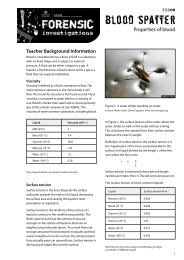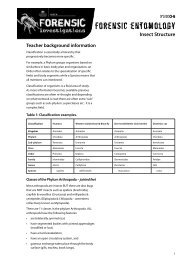FSB 03 [PDF File, 151.9 KB]
FSB 03 [PDF File, 151.9 KB]
FSB 03 [PDF File, 151.9 KB]
Create successful ePaper yourself
Turn your PDF publications into a flip-book with our unique Google optimized e-Paper software.
<strong>FSB</strong><strong>03</strong>blo o d spatte rWhat is Forensic Science?Teacher background informationWhat is forensic science?DefinitionForensics is the term given to an investigation of acrime using scientific means. It is also used as thename of the application of scientific knowledge tolegal matters.HistoryForensic science has developed over the past 300years or so, and its processes continue to improveand evolve today as science and technology findbetter and more accurate techniques. In 1929 the firstAmerican forensic lab was created in Los Angeles bythe police department.What are the different areasof forensic science?Forensic science covers many areas of traditionalscience and melds them together to create an area ofscience called forensics. Forensic science uses areas ofscience such as:•••Chemistry (chromatography, spectroscopicanalysis, pH and other chemical tests)Biology (entomology, fingerprinting,behaviour, hairs, DNA testing etc)Physical science (blood spatter analysis, ballistics,structural analysis, car movements in car accidents)Forensic science is an umbrella term that has variousareas under it. When a crime is committed and theforensic team is called in, there are many expertswho cover their specialised fields. Although all thesepeople could be considered forensic scientists, theyhave specific areas that they work in.There are two main areas of forensic science andthese are the minimum requirements for a criminalinvestigation:•Field officers – these are technicians whovisit the scene of a crime and collect thephysical evidence that may be related to thecrime. They also document and record thescene by taking photographs and videos.•Lab officers – these are technicians whoanalyse and completed tests on theevidence collected by the field officers.As well as these basic roles, in some areas such ascities, where there is often more criminal activity.Sometimes the above 2 roles are broken into expertareas. These include:••••••Crime scene investigator – these are thepeople who visit the scene of the crime to find,collect, protect and transport all the evidencethey have collected back to the crime lab.Latent print examiner – this specialist examinefingerprints, palm prints and footprints.Firearms examiner – this expert examines theevidence to identify what sort of firearm wasused by comparing bullet and shell casings andsearching for and identifying gunshot reside.Tool mark examiner – this person is similarthe fingerprint examiner, but rather thanlooking for human fingerprints they insteadlooks for any distinctive marks that may havebeen left by tools that the criminals used.Document examiner – this specialist examinesany documents left at the scene. Documentexaminers determine authenticity and authorship.They also look for any alterations that may haveoccurred to original documents and may beasked to ID if a particular copier or typewriterhas been used in the creation of a document.Trace evidence examiner – these experts’ analysesand compare any traces that the criminal mayhave left behind. This person is responsible foranalysing and comparing hair, fibres, glass, soiland paints to work out their type and origin.While the above roles relate to all crimes, there aresome additional experts who are called upon if thecrime involves finding a body. The roles specificallyrelating to examining remains or murders are:• Forensic pathologist – this person is responsiblefor examining the body, undertaking autopsiesto determine cause of death and is required tocollect any evidence that can be found on or in thevictim. Forensics pathologists may also examineliving victims to determine the causes and ages ofinjuries the live victim may have received during
<strong>FSB</strong><strong>03</strong>blo o d spatte rWhat is Forensic Science?•••the crime. The forensic pathologist uses autopsyreports, police reports, medical records, suspect/ witness interviews and the results of crime labevidence analyses in the pursuit of answers.Forensic anthropologist – in the case whereremains are difficult to identify or are skeletal aForensic Anthropologist is called in. These expertscan use scleral remains to work out age, sex andrace of the deceased. They can also identify anyinjuries or illnesses that the victim may havesuffered and sometimes can even establish thetime of death. Forensic Anthropologists can alsouse remains to do toxicological, chemical andDNA tests to help them discover more about thevictim. These experts don’t just do lab work,but they can also find pout a lot by visiting thelocation of where the remains were found.Forensic odontologist – these experts arebasically forensic dentists. The help to IDbodies by looking at and matching dentalpatterns with dental records collected fromdentists. They also are called in, in caseswhere there are bite marks or teeth found.Forensic entomologist – Entomology is the studyof insects. A forensic entomologist uses theirknowledge of insect life cycles to determinetime of death. It is common for bodies that havebeen found sometime after death to be invadedby hungry insects. This expert can also usetheir knowledge of where different insects liveto work out if a body has been moved or not.Where and when is forensics used?These days forensic science is used to investigatenearly all crime scenes. With the advancementsof science, most forensic science techniquesare a common and necessary part of a criminalinvestigation.Why is it important?There has always been a role for forensics science incriminal investigations, but with criminals committingclever, well thought out crimes more often,forensic science is now an essential tool for criminalinvestigations.Imagine that you witness a crime. You see a burglarsneaking away from a jewellery store late at night.It is dark and rainy. You call the police. When thepolice arrive, they interview you and you give themdetails of whom you saw leaving the store. They sendtheir forensics team and the team discovers that thefingerprints on the safe, on the damaged shop doorand on the window where the intruder escaped, don’tmatch the person the police have apprehended basedon your description. They match a criminal known topolice as a jewellery thief and who already has theirfingerprints recorded in the police database.Who do you think the crime points to? The personyou identified on this dark and stormy night, or theperson who all the evidence incriminates? In a courtof law, which person is the jury most likely to convict?This is the role of forensic science. It is a techniquedesigned to either identify the perpetrator or toconnect them to the crime so that they can beconvicted based on unbiased, unquestionableevidence. It is designed to convict the person whocommitted the crime, not the person who looked likethey committed the crime. So while it is a techniquethat attempts to put criminals in jail, it is also used toprotect the innocent.What skills are involved in forensic science?Forensic science uses a lot of different skills. Theseinclude:••Observational skills – to be able to find andcompare evidence. To be able to discover thingsthe untrained eye may miss. Observational skillsdon’t just relate to sight, smells, sounds and howthings feel are also important in investigationsand can give clues that may crack a case.Evidence collection and analysis – this is vitalto the role of a forensic scientist. Evidencethat is collected needs to be documented welland it is crucial that contamination of evidencedoes not occur. To collect evidence a forensicscientist needs to be methodical and accurate.• Scepticism – healthy scepticism is an importantpart of investigating crimes. Everyone is a suspectuntil something concrete proves otherwise. Itis also important to understand that witnessaccounts aren’t always very accurate. It hasbeen found that when referring to memories(such as during a witness account) most peoplehave trouble getting all details correct and
<strong>FSB</strong><strong>03</strong>blo o d spatte rWhat is Forensic Science?most people’s perceptions are based on theirpersonal lives and values. For example, a witnessmay state that they saw a woman leaving thecrime scene. You may think that this eliminatesmen from the investigation. But what if it wasa man with long brown hair? It is quite easy forwitness perceptions to be inaccurate and whilewitness statements are an important part of aninvestigation, healthy scepticism is as well.Tool kit for a forensic scientistThose forensic scientists required to find, collect,protect and transport evidence from the crime scenerequire a kit of tools to use. Although each forensicscientist may do things a little differently, there aretypical tools that they all use. These are:••Crime scene tape to secure the scene and thearea around which the crime took place.Camera and film to photographscene and evidence.• Gauges to place in photos to allow for scale.• Sketchpad and pens for scene sketches.•Disposable and protective clothing (overall suits),face masks and gloves (usually latex gloves).• Torch.••••••Other light sources such as laser, ultraviolet (UV) and infrared (IR) lighting. Thesedifferent lights can uncoer certain types ofevidence that normal torchlight wont.Magnifying glass to help withfinding trace evidence.Tweezers for collecting evidencesuch as hair and fibres.Cotton wool bubs (cotton swabs) forcollecting samples of fluid evidence.Evidence bas (paper and plastic) and evidencetubes (plastic and glass) and marker pento label evidence. This assists in keepingevidence uncontaminated and allows forsafe and easy transport to the lab.Fingerprint supplies – this includes things like ink,print cards, lifting tape, dusting powders (thereare a variety of these for different situations)and exposing reagents (such as luminol).•Casting kits for making casts of shoe/footwearprints, animal prints, tyres and tool markings.• Serology kit for collecting blood.••Entomology kit for collecting andpreserving insect evidence.Hazard kit for handling hazardousmaterials/evidence.Crime scene proceduresWhen investigators attend a crime scene, there is a listof procedures that they follow. These procedures mayvary depending on the crime they are investigatingor on the country, but generally the procedure is asfollows:••••Preserving life – whatever the type of crimescene. The first priority is to preserve lifeand assist any victims if they are injured.Suspects at the scene – suspects should bedetained and removed from the scene. Thisalso allows for searches, statements andbehaviour to be documented. Sometimestheir clothing or objects in their possessionmay be seized for use as evidence.Detaining witnesses – this means detainingboth willing and reluctant witnesses. Thesepeople are not always eyewitnesses. Witnessesshould be separated so that they don’t have theopportunity to discuss what they saw betweeneach other and taint their recollections.Controlling the scene – the more people whocome in contact or visit the crime scene, the moredifficult it is to keep the site uncontaminatedand for investigators to collect evidence.• Examination of the crime scene – this is the partwhere forensic scientists methodically collectevidence; take photos and document the scene.It is best to record and collect evidence that maybe easily destroyed first and then investigatorsmove onto the more stable evidence.While on TV shows such as CSI, Forensic Investigatorsare seen interviewing witnesses, in “real” life ForensicInvestigators have no contact with witnesses, suspectsor others. The role of Forensic Investigators is purelycollection and analysis of evidence. It is up to the policeto interview and put the pieces of the crime together.
<strong>FSB</strong><strong>03</strong>blo o d spatte rWhat is Forensic Science?CSI EpisodesSeason 1Friends & Lovers Episode #004Autopsy. ~ Chemical analysis. ~ FIngerprints. ~‘Stringing’. ~ Dental imprints. ~ Swabs. ~ Bloodsplatters.Who Are You? Episode #005Reconstructing facial through forensic anthropology.~ ALS light to find bloodstains. ~ Dismantling vehicleto find bullet.Blood Drops Episode #006Polygraphs. ~ Blood splatters at crime scene. ~Electrostatic dust printer lifter. ~ Swabs. ~ Tire tracks.~ Sara used camera to detect unseen bruises onBrenda.Season 2Scuba Doobie-Doo Episode 27Blood spatter“Fur and Loathing” is the fifth episode of the fourthseason of CSI: Crime Scene Investigation.Blood spatter(Season 4, Episode 10) – blood spatter#408 - AFTER THE SHOW (Nov 20 20<strong>03</strong>)expt with blood dropsUnfriendly Skies Episode #008Autopsy. ~ Matching shoeprints. ~ Swabs.~ Photocomparisons. ~ Dummies to simulate bodies.~ Reenactingcrime scenes.Sex, Lies and Larvae Episode 9Entomology (bugs). ~ Blood splatters. ~ Phenothaline.~ Earprints.1-15 Murders Episode #010Handwriting analysis, hackle marks, VICAP, amylase,float glass, autopsy, satellite tracking, HLA-DQA1, STR-DNA, water density tests.Justice is Served Episode #020Forensic odontology, Luminol, Leuco-MalachiteGreen.Evaluation Day Episode #021Size of footprints found at crime scene in Collins-Store-It unit, as well as some shoes found in Victor DaSilva’s closet. They belonged to Fred Applewhite. TrentCalloway’s shoe size.


![FSB 03 [PDF File, 151.9 KB]](https://img.yumpu.com/43260078/1/500x640/fsb-03-pdf-file-1519-kb.jpg)
![FSP 19 Anthropometry [PDF File, 298.3 KB]](https://img.yumpu.com/51210323/1/184x260/fsp-19-anthropometry-pdf-file-2983-kb.jpg?quality=85)


![FSE 09 Case studies [PDF File, 140.2 KB] - Centre for Learning ...](https://img.yumpu.com/48750159/1/184x260/fse-09-case-studies-pdf-file-1402-kb-centre-for-learning-.jpg?quality=85)
![FSE 03 [PDF File, 125.2 KB] - The University of Western Australia](https://img.yumpu.com/47991868/1/184x260/fse-03-pdf-file-1252-kb-the-university-of-western-australia.jpg?quality=85)
![FSE 01 Overview [PDF File, 163.0 KB]](https://img.yumpu.com/47583056/1/184x260/fse-01-overview-pdf-file-1630-kb.jpg?quality=85)
![FSE 10 Teachers activity [PDF File, 3.0 MB] - Centre for Learning ...](https://img.yumpu.com/45506425/1/184x260/fse-10-teachers-activity-pdf-file-30-mb-centre-for-learning-.jpg?quality=85)

![Chapter 03 [PDF File, 468.5 KB] - Centre for Learning Technology](https://img.yumpu.com/44881443/1/184x260/chapter-03-pdf-file-4685-kb-centre-for-learning-technology.jpg?quality=85)
![Chapter 09 5 [PDF File, 192.4 KB]](https://img.yumpu.com/44599682/1/184x260/chapter-09-5-pdf-file-1924-kb.jpg?quality=85)

![FSE 11 Rearing flies [PDF File, 388.4 KB]](https://img.yumpu.com/41885287/1/184x260/fse-11-rearing-flies-pdf-file-3884-kb.jpg?quality=85)
![FSP 26 Crime Dossier [PDF File, 3.2 MB]](https://img.yumpu.com/36466452/1/184x260/fsp-26-crime-dossier-pdf-file-32-mb.jpg?quality=85)
![FSE 07 Forensic entomology [PDF File, 196.9 KB]](https://img.yumpu.com/35416705/1/184x260/fse-07-forensic-entomology-pdf-file-1969-kb.jpg?quality=85)